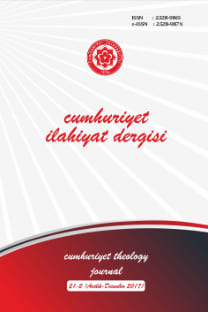ARAP DİLİNDE BAGIMSIZ YARGI BİLDİREN CÜMLELERİ İSiMLEŞTiREN EDAT VE TERKiPLER
cümle, isimleşmiş cümle, nitelik bildiren müştak isim siygaları, yargı, kavram
The Prepositions And Compounds Whlch Turn The Sentences Into A Noun (Nominalization) In Arabic
sentence, nominalizated sentence, forms of derived nouns, the judgment, the concept,
___
- Abbas J::Iasan, en-Nal;vu '1-viifi, Daru'I-ma' arif, 9-10. baskı, 1$-ahire 1991-
- 1992.
- A~med el-Haşim!, el-.((avaBeyrut trhsz.
- 'Ali J::Iasan Matar, "Muştal~at n~viyye 18", Mecelletu Turiişinii, S. 1 (65),
- yıl: 17, Mul}arrem-Şafer-Rebt'u'l-evvel, Kum 1422 h. (ss. 207-214)
- (web adresi: http://www.rafed.net/books/turathona/65/tlO.html 01-
- 12-2005)
- ISSN: 2528-9861
- Yayın Aralığı: 2
- Başlangıç: 1996
- Yayıncı: Cumhuriyet Üniversitesi İlahiyat Fakültesi
AHMED HAMDI'NİN MANZUM ABDÜL VEHHAB-I GAZI MENAKIBI
OSMANLI'DA AİLE BİREYLERİNİN GÖREVLERİ VE SORUMLULUKLARI
Sabatayizmin Avrupa Yahudiliğine Etkileri
Arapça'da Meani (Semantik) Açısından Atıf (Baglama) Edatları
BABERTI'NİN, VASİYYE VE TAHAvi AKİDESİ ŞERHLERİNDE "İMAN VE İSTİTAAT" HAKKINDAKi GÖRÜŞLERİ
BABERTI'NİN, VASİYYE VE TAHAvi AKİDESİ ŞERHLERİNDE "İMAN VE İSTİTAAT" HAKKINDAKi GÖRÜŞLERİ
ZİLE Li MUHARREM EFENDi (X.!XVI. ASIR) VE "HEDİYYETÜ'ş-şU'LUK" ADLI ESERi
ZİLE Li MUHARREM EFENDi (X.!XVI. ASIR) VE "HEDİYYETÜ'ş-şU'LUK" ADLI ESERi
CİHAN AKTAŞ'IN HiKAYELERİNDE ÖTEKİLEŞTİRİLMİŞ BAŞÖRTÜLÜ KADlNLAR
